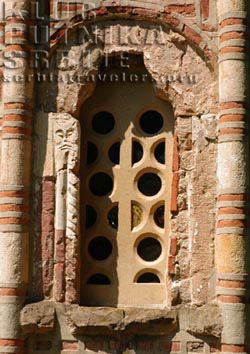Ravanica Monastery
Ravanica Monastery is located about 10 km east of the town of Ćuprija, on the road going to Despotovac via the village of Senjski Rudnici. It is considered to be one of the most impressive buildings of the Moravska architectural style.
Ravanica Monastery was built in the late 14th century, by king Lazar, who was killed in the Battle of Kosovo a couple of years after having completed the monastery.
Like many Serbian medieval monasteries, Ravanica used to be heavily fortified, and the remainings of the walls can still be seen surrounding the complex.
History of Ravanica Monastery
Ravanica Monastery was the largest, most important foundation by king Lazar Hrebeljanović. It was built between 1376 and 1381, which was described in the famous folk poem "Building Ravanica". The poem says that queen Milica talked her husband, king Lazar, into constructing a monastery for the salvation of his soul, after the example of ancient Serbian royal dinasty Nemanjics.
Decided to make a building more beautiful than anything ever built in medieval Serbia, Lazar chose most precious construction materials, as well as gold and pearls for ornamentation. However, his wise brother in law, Milos Obilic, knowing that the Turks were already at the borders, told the king that this was no time for wasting money, because the Turks would likely come and take everything. Instead, said Milos, it should be built of stone, because "stones will not be coveted". Apparently, he was right, because Ravanica Monastery still stands, more than six centuries later.
First Turkish raids of the monastery began right after the Kosovo Battle in 1389, when king Lazar was killed, but the monks somehow managed to survive there. However, Ravanica Monastery became deserted after the Great Migration of Serbs in 1690, when the monks took the relics of king Lazar and moved them north, to Vrdnik Monastery in Fruska Gora.
Ravanica Monastery became active again in the 18th century.
The relics of king Lazar traveled an interesting path in the past 600 years. After the king's death in the battle, his body traveled around Serbia, to finally be buried in Ravanica Monastery in 1392. However, in 1690. they were moved to Sent Andrea, today a suburb of Budapest, and from there to Vrdnik Monastery, where they stayed until 1942. In the WWII, because of the looming danger of Ustase (Croatian fascist troops) the relics were moved to central Belgrade. King Lazar's relics were finally returned to Ravanica Monastery in 1989, exactly 600 years after his death in the Battle of Kosovo.
Getting to Ravanica Monastery
Take a bus or train from Belgrade to the town of Ćuprija. There are buses from morning till evening, approx. every hour. All the trains going to Nis (at least 10 daily trains) also pass through Ćuprija.
In Ćuprija, get on a local bus to the village of Senje or Senjski Rudnik. From there you have another 1-2 km to the monastery, which can easily be done on foot.
If you're traveling by car, take the E75 highway connecting Belgrade and Niš, and exit the highway at Ćuprija, but on the left side (so that Ćuprija stays to your right, and the road to Ravanica is to your left when coming from Belgrade; you'll see the road sign for the monastery). Then just go straight, along the Ravanica River, through the village of Senje, and you'll see Ravanica a couple of kilometres later, on the road to Senjski Rudnik.
{tab=things to see}
What to see in Ravanica Monastery?
 Construction of the church in Ravanica marked the beginning of the Moravska Style in medieval Serbian architecture and painting. This architectural style is known mainly for its complex relief ornaments on the facades, rosettes, intricate windows as well as the decorative technique of arranging alternate layers of stones and bricks, with an abundance of details. Apart from Ravanica, other important monasteries belonging to Moravska Style are Kalenic, Naupara, Ljubostinja etc.
Construction of the church in Ravanica marked the beginning of the Moravska Style in medieval Serbian architecture and painting. This architectural style is known mainly for its complex relief ornaments on the facades, rosettes, intricate windows as well as the decorative technique of arranging alternate layers of stones and bricks, with an abundance of details. Apart from Ravanica, other important monasteries belonging to Moravska Style are Kalenic, Naupara, Ljubostinja etc.
Ravanica Monastery consists of the Ascension Church, dining room and dormitory, as well as the remainings of what was once powerful fortification with seven towers, that protected the monastery in ancient times. The highest tower was also a chapel, now mostly in ruins.
Frescoes in Ravanica Monastery date from 1387. On the fringe of one of the Holy Wariors' robe there is a signature belonging to one of the church painters, whose name was Constantine. This is rather unusual, since medieval fresco painters rarely left any trace as to their identity.
The parvis was rebuilt and decorated in the 18th century, when the monastery was restored after a long period of inactivity.

